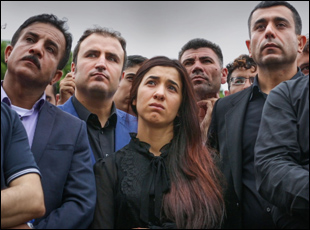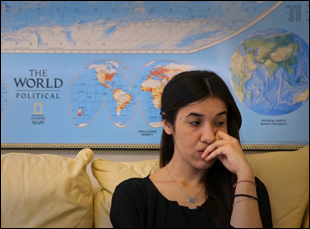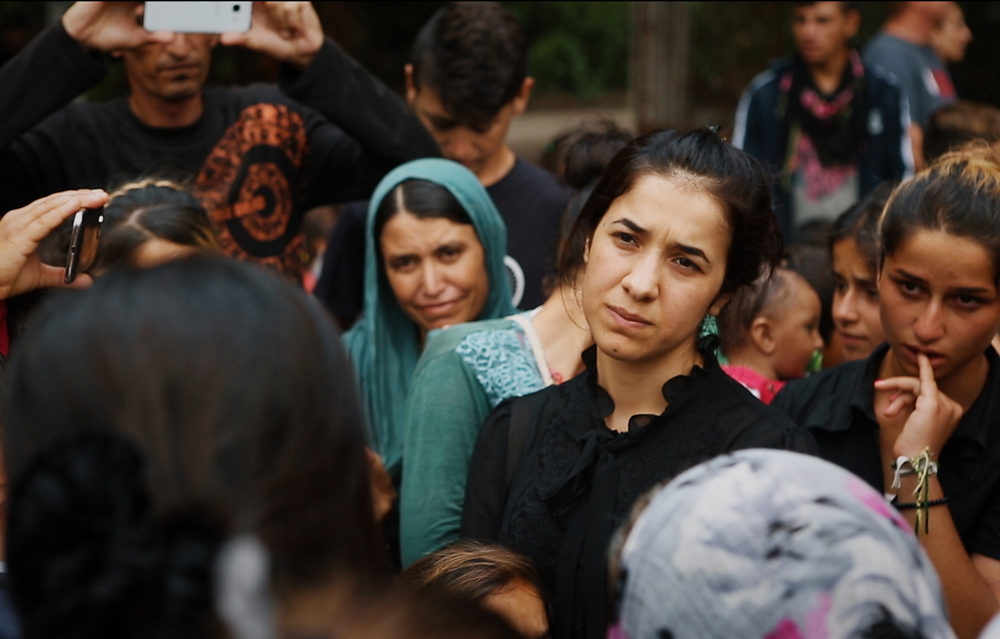Alexandria Bombach was being extremely picky with with her words. She was holed up on a tiny island in Greece for three months, working on what would eventually become her latest film “On Her Shoulders.” after locating the best person to translate Kurmanji, the native tongue of Nadia Murad, a 23-year-old survivor of the 2014 genocide of the Yezidi community in Northern Iraq at the hands of ISIS who has since made it her mission in life to let no one forget what happened there, no matter how much it pains her to remember herself. But Bombach also had to be cautious about what she said to the film’s financiers at RYOT, the humanitarian doc house who secured access to Murad in the first place with the intention of a short profile when she thought Murad, who would go on to win the Nobel Peace Prize this year, was more deserving of a feature and all she had to do was edit the footage she already had.
“You take a chunk out of somebody’s life making a film about them and there’s a sense of responsibility that I had that was so much greater than pissing off a company,” recalls Bombach of the fateful Skype call in which she had to mislead her producers while using the time earmarked to translate to build a feature. “I don’t feel like I could’ve lived with myself if I didn’t do true justice to this story, so I didn’t feel like I had an option…it was a huge risk and I applaud them for [ultimately] taking it.”
Ironically, it was a demonstration of courage that showed producers why they were right to entrust Murad‘s remarkable story to Bombach in the first place. Coming off of “Frame by Frame,” in which she and Mo Scarpelli traveled to Afghanistan to chronicle the lives of four native photojournalists bearing witness to the atrocities being committed in the Middle East for the world to see and the personal toll it takes, Bombach has embarked on an equally affecting and even more provocative endeavor with “On Her Shoulders,” shadowing Murad as she recounts the experience of the massacre and her requisite time as a sex slave for foreign dignitaries, Western journalists and eventually the U.N. Security Counsel with an all-consuming aim of drawing attention to the situation that will lead to action.
Murad, endlessly compelling and eloquent in spite of how many times she’s had to relive her trauma for the benefit of others, will never suggest this is too much of a burden, but Bombach boldly asks if it is as she captures not only a portrait of Murad, but also how the media is prone to shape a certain image of her and why we as a society demand to hear such horror, regardless of its implication on who lived it, in order to be moved to do something about it. While countless other documentaries have enabled these international tragedies to be seen around the globe, “On Her Shoulders” is a breakthrough in offering a true understanding of how destructive they are well after they’ve happened and what we’re really asking when we ask for proof. It’s an exquisite and eye-opening film that Bombach was right to champion as a feature befitting of its extraordinary subject and as “On Her Shoulders” begins to make its way into theaters around the country, including current runs in Los Angeles and New York, the director spoke of how she could be protective of Murad and the shrewd filmmaking techniques she used to get inside of her experience without exploiting her.
In July of 2016, RYOT, the production company reached out to me and asked me to direct a short film about Nadia and I immediately was very interested because of “Frame by Frame” and my interest in telling stories about storytellers — how we’re packaging stories of trauma and what we’re doing with them, especially at a time when there’s so much apathy for the refugee crisis and our digestion of stories, really focusing on the sensationalism of them. Advocacy was such an interesting thing to dive into after photojournalism because you’re talking about the power of a photo and this is talking about the power of a story and I was interested in what the repetition [of having to tell the story] was like for her and the impact it was having. I was paying a lot of attention to the genocide that was happening in 2014 against the Yezidis and then I remember seeing Nadia’s speech in 2015 in December at the U.N. Security Counsel, so I immediately said yes. Two weeks [after meeting with RYOT], I met Nadia in New York and it became almost immediately obvious it should be a feature film. I went through production advocating for that, but it was very hard for the production company to see that, so it was a pretty wild start.
What was it like meeting Nadia for the first time?
I had no idea what to expect and I was very, very nervous because there’s a process that you’re going through to get access to stories as a documentary filmmaker. I knew very well the trauma that she had gone through through from reading about it, but I had never worked closely day to day with someone that had such traumatic violence and had been through such a horrific event, so I didn’t know how she would react to me. I also was very cautious about the access that we were given was because she has survivor’s guilt and she wants her story to be told. If it was her choice, I wouldn’t be there, but she feels almost [like], “Okay, I need to do this. It would be good for the Yezidis,” so that’s a strange access to have as a documentary filmmaker. I wanted to be conscious of that going in and while a lot of people focus on her strength and resilience, two of the most important attributes of her personality to me [was how] incredibly gracious she was with me in allowing me into this world and also being very patient with me, which was just above and beyond what I expected from somebody who has already been through so much.
At what point did you decide to do the central interview that’s in the film?
After researching Nadia so much, it was just so apparent that she had done so many interviews where she was two-thirds of the frame telling her story and I was very conscious of how people were expecting how this film would come across. There’s so many tropes that you can fall into, especially for one woman from the Middle East that are common stories that we are used to hearing in the United States [where it’s a] woman activist from the Middle East who is going to tell us her sad story and I really wanted to confront people with how problematic that narrative repeating itself has been.
In that need for confronting, I wanted Nadia to look directly at us and also have nothing around her, so you’re just focused on her and you have to look her in the eyes as she’s telling you this, which has never really happened before. I also put so much energy and focus in translation because I wanted the little breaks in her speech or when she would change her mind in what she was saying or messing up and correcting it or having moments of pause to be in there unedited because we’ve only heard her from live translators or from translators sitting next to her. As far as the Western world, it’s never been her voice, so it was really important to me to put as much nuance and care into that process as possible.

Emotionally, things are pretty obvious from body language as to what’s going on. Little conversations, like the guy coming up to her during the rally and telling her, “Don’t cry,” it was obvious to me he’s encouraging her and she’s sitting up, but to [actually] say the words, “Don’t cry, they’re all depending on you,” you’re hoping the sentiment and the feeling is coming out in someone’s dialogue so you can show that to the audience. Those were moments where I was like, “Oh, crap, that has to go in there.” But it’s always challenging to make a film in another language and try and guess what’s going on.
I was trying to figure out the right way to phrase this because it doesn’t seem like she ever loses touch with the emotions of telling the story, but just in order to protect herself if not becoming a force of habit, she must tell the story at a certain point in a way that it’s somehow calcified or removed from her. Is that something you have to break through?
There are two answers to that – I didn’t know what the experience was going to be like for her repeating her story and I thought there would be some calcification, but I don’t feel that way at all. Watching [Nadia] do interviews, it seemed like it completely opened her chest every single time she told that story and it didn’t seem like she ever got used to it or it ever got normal, which was powerful and difficult to witness. And this is the second part of the question for me – I did not ask her to do that again and purposely avoided those horrific details in the film, like focusing on how she escaped because I didn’t want to put her through that. It wasn’t necessary for the story, but second I really wanted the audience to question why we feel we need to know those things in the first place. Where is that want coming from?
Was the film always going to be about the idea of testimony?
I really don’t try and go in with [preconceived ideas], especially with this. [RYOT] just got access to her, so they didn’t really know what they wanted and thankfully, because they didn’t know what they wanted, I was able to really pay attention to what was there and being with Nadia and feeling how this campaign felt is what shaped how the story was told.
One of the more remarkable aspects of the filmmaking is how you’ll depict Nadia in relation to the environments she’s in – it’s always amazing to me how someone is conscious of that when you’re doing it on the fly, but were there rules in your head about what to capture and how to capture it?
Yeah, this grew more in the edit than in the shoot, but I think it just happened naturally because I was focusing so much on her that a lot of the footage that is in the film are closeups because I want the audience to almost feel like they’re sitting next to Nadia – not looking at her, but sitting next to her – while all of these things are happening. Then in the interview, she is looking right at you, so there was an intimacy that I wanted to create. [For shots] on the fly, there’s a lot of stuff on the cutting room floor that’s pretty disastrous [as far as compositions]. It was really, really hectic because they’re always moving so fast and [they were in] not very attractive rooms – at the U.N. or the meeting rooms, [there’s] fluorescent lights and it’s all pretty gross, and because it was so chaotic and everything always looked so gnarly, I tried to focus on getting shots that presented them in portrait in a way that there was almost this flat symmetry, to calm the hecticness around it. It was always trying to get everything within a frame to calm the viewer’s eyes.
Was there a particularly crazy day of shooting on this?
They were all nuts. [Nadia’s] schedule at that time, especially at the peak of their campaign was 7 a.m. to 2 a.m. just working, working, working and it felt it was never enough. It was not sustainable. It was just such an intense time and in a three-month period, I was probably with her for two months. I was completely exhausted and I was filming, so I can’t imagine how draining for her that was and still is, just the emotional drain and people wanting from her all the time every single day and then just trying to push to the next place. And we never knew where they were going next. We were in Greece and the idea of them going to Australia happened within a two-day period, so it was really, really fast, like “Ahhhh…” We had no idea what was going to happen day to day.

Something that was obvious to me early on [from] watching [Nadia] do interviews wherever we were in the world was that her story and the loss of her family and the trauma that they’ve all been through is something that’s very present. So I wanted to convey some sense of a living memory constantly being with her day to day and I felt sound was the best way to tactfully convey that emotion. The use of silence and rising noise and how trauma can feel was super important to me and that was very well executed after post-production with Lawrence Everson, my sound designer, and with my editor Michael Bucuzzo, who’s also very good with sound. We collaborated in a way that was wonderful because it felt like we both could feel these moments of emotion and when they should be loud or quieter and contrasting between the two.
Hopefully, they’re watching it in a great theater, but sometimes that’s not always a case and I actually tell people I hope they watch the film with headphones and a laptop when they’re not getting the full sound experience. We watched it at the U.N., which was just heartbreaking because of course the sound system is not good [there], one of our co-producers Elizabeth Schaefer Brown came up to me after and said, “something was missing” and I said, “Yeah, it was the sound.” So it’s half of the film for me.
Speaking of screening at the U.N., what’s it been like to travel with this?
I’ve been so thankful that people get it, understanding what it is – and it was the same with “Frame By Frame.” You’re always going to have the end of the bell curve of people reading the synopsis or seeing the poster think it might be like the “Malala” doc, and that’s been the biggest hurdle. It’s hard to get people in the room for this kind of film. But once people see it, they really get it and that’s been really wonderful, though it’s been really strange and exhausting and weird to win awards for a film, just because of the context of it. But I hold onto the fact that so many people have said what I was trying to do right back at me, so it’s really nice.
“On Her Shoulders” is now playing in New York at the Village East Cinemas and opens on October 24th in Los Angeles at the Monica Film Center. A full schedule of theaters and dates is here.





